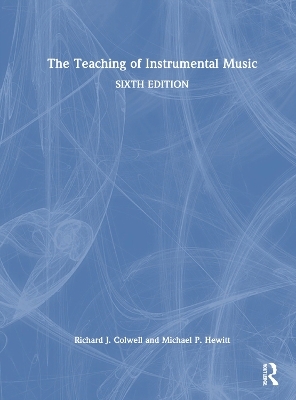
The Teaching of Instrumental Music
Routledge (Verlag)
978-1-032-52502-0 (ISBN)
The Teaching of Instrumental Music, Sixth Edition, introduces music education majors to basic instrumental pedagogy for the instruments and ensembles commonly found in the elementary and secondary curricula. It focuses on the core competencies required for teacher certification in instrumental music, with the pervasive philosophy to assist teachers as they develop an instrumental music program based on understanding and respecting all types of music.
Parts I and II focus on essential issues for a successful instrumental program, presenting first the history and foundations, followed by effective strategies in administrative tasks and classroom teaching. Parts III, IV, and V are devoted to the skills and techniques of woodwind, brass and percussion, and string instruments. In all, The Teaching of Instrumental Music is the complete reference for the beginning instrumental teacher, commonly retained in a student’s professional library for its unique and comprehensive coverage.
This Sixth Edition includes:
Streamlined language and improved layout throughout, making this edition more concise and accessible to students.
Updated content throughout, including insights from current research for curriculum development, coverage of current law and policy changes that impact the classroom, contemporary motivational strategies, and more information on the history of African-American and all-female music ensembles.
Updated references, photos, lists of artists, and online resources.
Richard J. Colwell is in the Music Educators Hall of Fame and received special citations from the International Society for Music Education, Illinois Music Educators Association, and National Federation of Music Clubs, and the John Simon Guggenheim Memorial Foundation. He founded the Bulletin of the Council for Research in Music Education and the Quarterly Journal of Music Teaching and Learning. Michael P. Hewitt is Professor of Music Education at the University of Maryland, and founder and director of the University of Maryland Terrapin Music Camp. He served on the editorial boards of the Journal of Research in Music Education and the Bulletin of the Council for Research in Music Education, and was elected to the Editorial Committee of the Society for Research in Music Education.
Part I – The Foundations
1. History of Instrumental Music
2. Teaching and the Role of Motivation
3. Objectives, Standards, and Curriculum Development
4. Assessment
5. Administering and Organizing the Program
6. Recruiting
7. Scheduling
8. Special Populations and Instrumental Music
9. The Physiology of Instrumental Music Performance
Part II – The Ensembles and Classroom Teaching
10. Planning for and Rehearsing Instrumental Ensembles
11. Planning for and Teaching Beginning Instrumental Students
12. The Marching Band
13. The Jazz Ensemble
14. The Guitar and Classroom Teaching
Part III– The Woodwind Instruments
15. Winds Principles
16. The Flute
17. The Oboe
18. The Clarinet
19. The Saxophone
20. The Bassoon
Part IV – The Brass and Percussion Instruments
21. Brass Principles
22. The Trumpet and Cornet
23. The Horn
24. The Trombone
25. The Tuba and Euphonium
26. Percussion Instruments
Part V – The String Instruments
27. Strings Principles
28. The Violin
29. The Viola
30. The Cello
31. The Double Bass
| Erscheinungsdatum | 20.11.2024 |
|---|---|
| Zusatzinfo | 2 Tables, black and white; 305 Line drawings, black and white; 11 Halftones, black and white; 316 Illustrations, black and white |
| Verlagsort | London |
| Sprache | englisch |
| Maße | 210 x 280 mm |
| Gewicht | 997 g |
| Themenwelt | Kunst / Musik / Theater ► Musik ► Instrumentenkunde |
| Sozialwissenschaften ► Pädagogik ► Schulpädagogik / Grundschule | |
| ISBN-10 | 1-032-52502-9 / 1032525029 |
| ISBN-13 | 978-1-032-52502-0 / 9781032525020 |
| Zustand | Neuware |
| Informationen gemäß Produktsicherheitsverordnung (GPSR) | |
| Haben Sie eine Frage zum Produkt? |
aus dem Bereich


